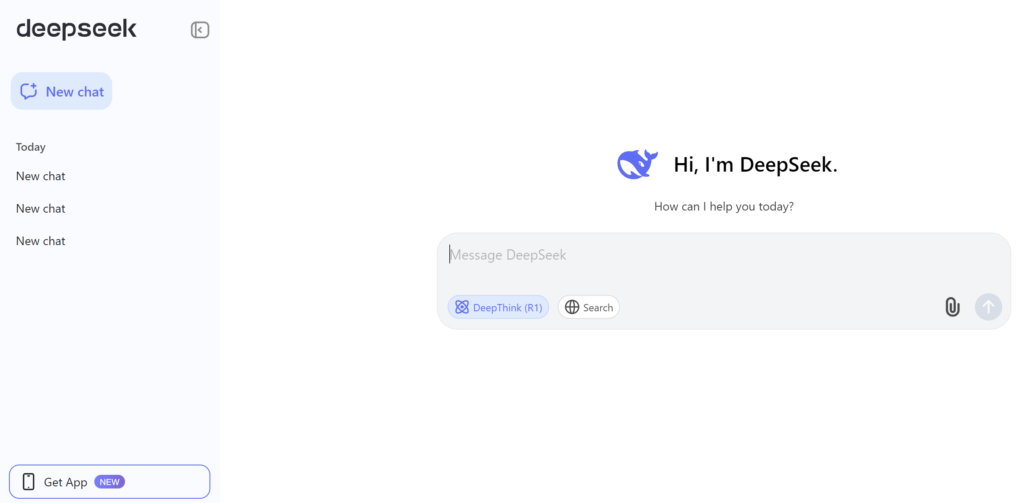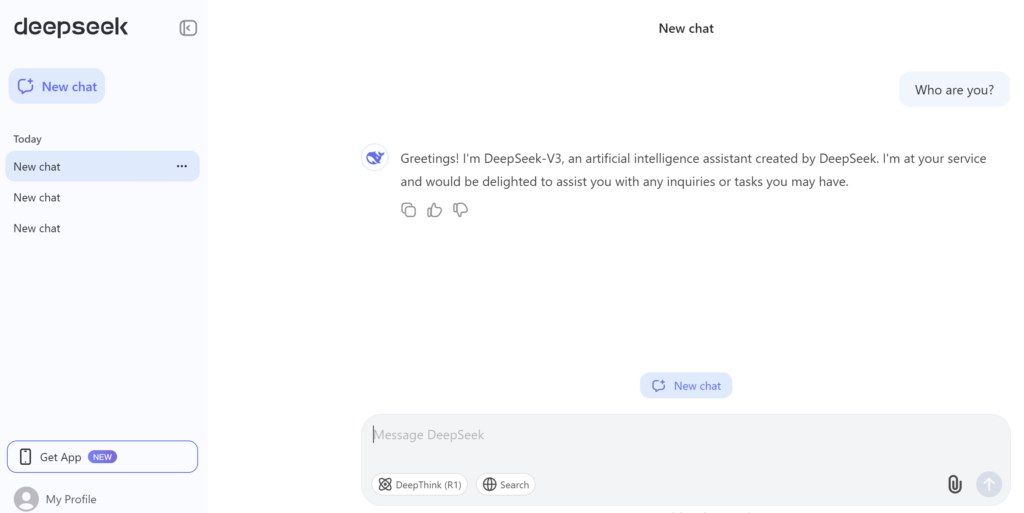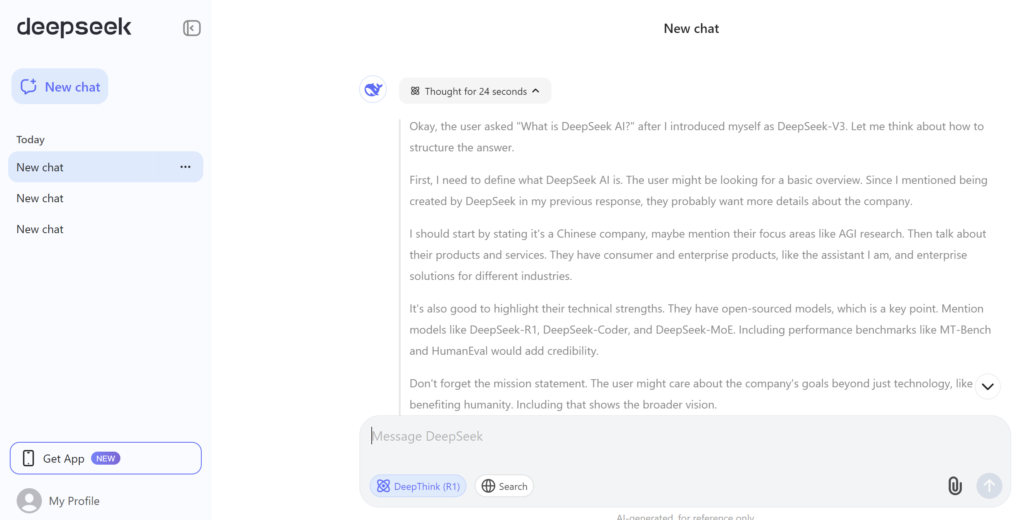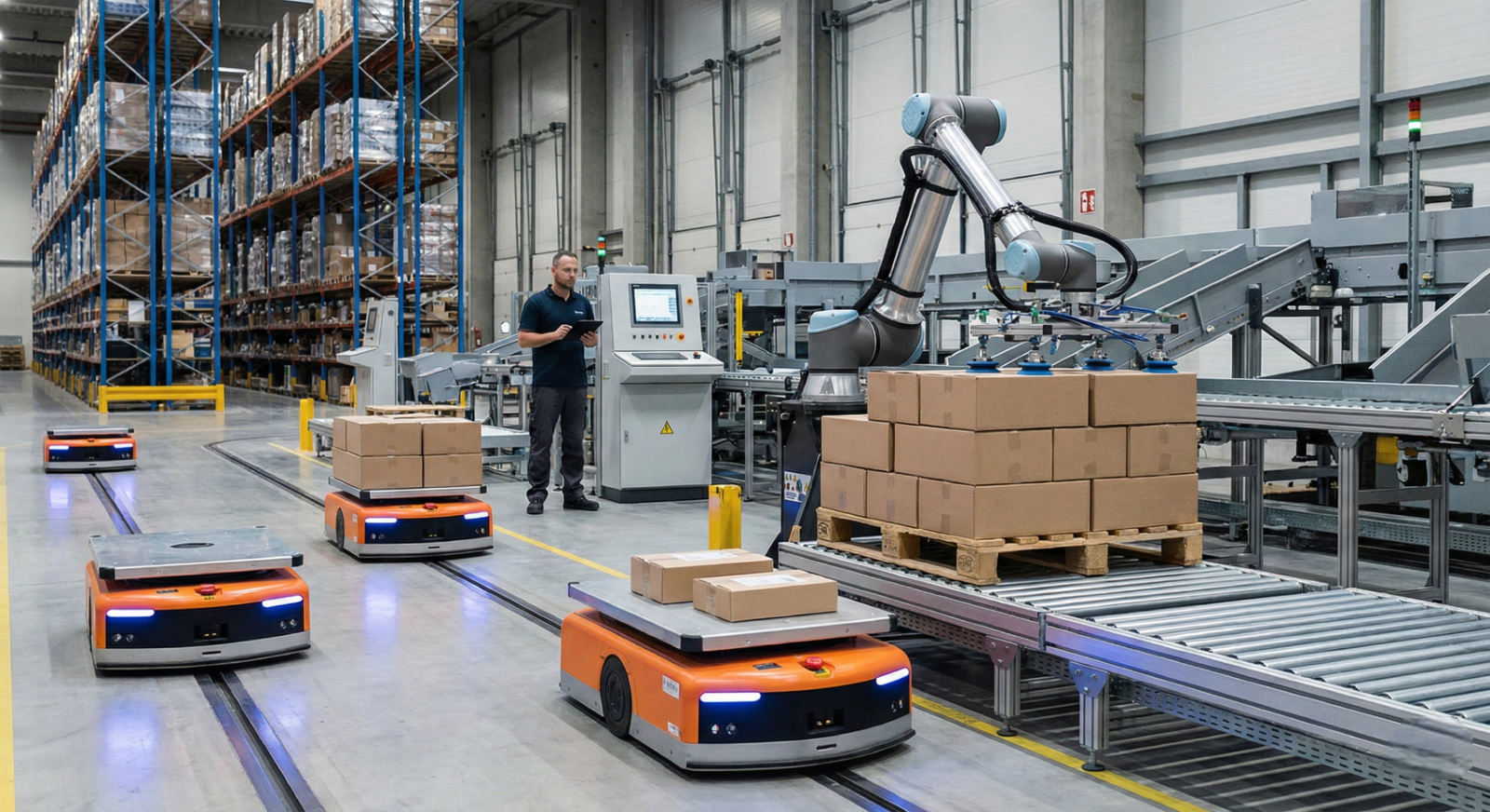DeepSeek AI is a Chinese artificial intelligence (AI) company that is gaining global attention. Its latest AI model, DeepSeek-V3, is making waves for being affordable, open-source, and as powerful as top Western models like OpenAI’s GPT-4. DeepSeek also recently became the most downloaded free app on the U.S. Apple App Store, beating ChatGPT. This success, along with its ability to work around U.S. restrictions on advanced Nvidia chips, has sparked debates about the future of AI and global politics.
This article explains what DeepSeek AI is, and how it is changing the AI industry and global power dynamics.
What is DeepSeek AI?

DeepSeek AI is a Chinese company founded in 2023 by Liang Wenfeng, a former hedge fund manager turned AI entrepreneur. The company focuses on creating advanced AI models, including large language models (LLMs), which can perform tasks like reasoning, coding, and content creation. DeepSeek’s goal is to make powerful AI accessible and affordable, challenging Western tech giants like OpenAI, Google, and Meta.
Its flagship model, DeepSeek-V3, is a 671-billion-parameter AI system (parameters are the parts of the model that help it learn and make decisions). What makes DeepSeek-V3 stand out is its high performance and low cost. Unlike many AI systems, DeepSeek shares its models openly, allowing developers worldwide to use and improve them.
DeepSeek’s success shows that the future of artificial intelligence depends on making it easy to use and affordable, not just on creating new technology.
Why is DeepSeek AI Making Headlines?
DeepSeek AI is making headlines for several reasons:
Topping the Apple App Store
On January 26, 2025, DeepSeek’s AI app became the most downloaded free app on the U.S. Apple App Store, surpassing OpenAI’s ChatGPT, which had long held the top spot. This achievement marked a turning point in the AI space. Between January 24 and 25, the app saw a massive 110% jump in daily active users compared to the same days the previous week. This rapid growth highlights DeepSeek’s rising popularity and its ability to compete with established players like OpenAI.
Affordable AI Development
DeepSeek reported that the training cost for DeepSeek-V3 was approximately $5.6 million, significantly lower than the hundreds of millions spent by companies like OpenAI on similar projects. Despite its cost efficiency, DeepSeek-V3 demonstrates competitive performance, matching or surpassing leading AI models in specific tasks such as reasoning and problem-solving.
Disrupting the Market
The release of DeepSeek-V3 caused a significant drop in U.S. tech stocks, particularly those tied to AI infrastructure. Nvidia, a key player in AI hardware, lost nearly $600 billion in market value in a single day, marking the largest one-day loss ever recorded for a company on Wall Street. This market reaction highlights the disruptive potential of DeepSeek’s innovations, which challenge traditional assumptions about the cost and infrastructure required for advanced AI development.
Open-Source Approach
By making its models open-source, DeepSeek is giving more people access to advanced AI technology. This move is helping smaller companies and developers compete in the AI market.
Who is Behind DeepSeek AI?

DeepSeek AI was founded in 2023 by Liang Wenfeng, a 40-year-old entrepreneur with a background in finance and AI research. Liang, who studied electronic information engineering at Zhejiang University, previously founded High-Flyer Capital, a hedge fund that leveraged AI for quantitative trading. Liang’s vision is to create a company that can compete with Western AI giants while supporting local talent.
Building a Team of Young Talent
DeepSeek’s team is predominantly composed of young graduates from top Chinese universities, including Tsinghua and Peking. The company prioritizes technical skills and innovation over traditional work experience, fostering a team of highly skilled and creative individuals. Notable team members include:
- Luo Fuli, a 29-year-old ‘AI prodigy’ specializing in natural language processing, who played a critical role in developing DeepSeek-V2.
- Gao Huazuo and Zeng Wangding, researchers recognized for their contributions to the Multi-Head Latent Attention (MLA) architecture, a key innovation in DeepSeek’s AI models.
Funding Model
DeepSeek primarily receives funding from High-Flyer, a hedge fund founded by Liang Wenfeng. This funding model supports DeepSeek’s focus on long-term research initiatives.
DeepSeek’s open-source ethos is a reminder that the future of AI is not about who controls the technology, but how many minds can come together to shape it for the greater good.
DeepSeek’s Product Lineup

DeepSeek has released several AI models, each designed for specific tasks:
- DeepSeek Coder: A model for coding tasks, released in November 2023.
- DeepSeek-V3: A general-purpose model with a mixture-of-experts architecture (a way to make AI more efficient), released in December 2024.
- DeepSeek-R1: A model focused on reasoning tasks, released in January 2025.
- Janus-Pro-7B: A vision model for understanding and generating images, also released in January 2025. Janus-Pro-7B is a smaller, multimodal model designed for tasks like text-to-image generation and visual content creation. It reportedly outperforms OpenAI’s DALL-E 3 in certain benchmarks.
DeepSeek AI vs. the Competition
DeepSeek’s rise in the AI industry is not just about technical innovation—it is also about how it measures up against leading models like OpenAI’s ChatGPT and Google’s Gemini. Here’s a breakdown of its competitive edge:
Key Comparisons
- Benchmark Performance:
DeepSeek’s R1 and V3 models compete strongly in areas like mathematics, coding, and natural language reasoning, often matching or outperforming rivals. - Cost Efficiency:
DeepSeek’s training and operational costs are significantly lower than competitors, proving high-performance AI does not require massive budgets. - Resource Optimisation:
By focusing on algorithmic efficiency, DeepSeek achieves top-tier results without relying on the largest datasets or most powerful hardware, challenging the idea that bigger is always better. - Open-Source Edge:
Unlike closed-source competitors, DeepSeek’s open-source models allow for greater customization and wider adoption, accelerating innovation across industries.
Industry Response
DeepSeek’s rise has sent shockwaves through the tech industry and global politics, reshaping perceptions of AI competition and power dynamics.
The “Sputnik Moment”
DeepSeek’s progress in AI has been called a “Sputnik moment” for the U.S. This refers to the 1957 launch of the Soviet Union’s Sputnik satellite, which surprised the U.S. and started the Space Race. Like Sputnik, DeepSeek’s rapid advancements in artificial intelligence (AI) have shown China’s growing strength in the field. This has raised questions about whether the U.S. can stay ahead in AI innovation. The situation has sparked new discussions about global competition and the need for more investment in AI research to keep pace.
Stock Market Turmoil
The release of DeepSeek’s models triggered a sharp decline in stock values for major tech companies, especially those reliant on AI infrastructure like Nvidia. Investors worry DeepSeek’s cost-efficient approach could disrupt traditional business models.
Tech Leaders’ Reactions
- OpenAI’s Sam Altman called DeepSeek’s models “impressive.”
- Microsoft’s Satya Nadella stressed the need to take China’s AI developments seriously.
- Meta’s Mark Zuckerberg pledged to speed up development of their open-source model, Llama, in response.
Nvidia’s Response
While Nvidia’s stock took a hit due to DeepSeek’s efficient use of fewer chips, the company believes DeepSeek’s success could eventually drive higher demand for AI hardware.
DeepSeek’s success shows how democratizing AI can level the playing field. By making advanced tools open and accessible, it empowers innovators everywhere to compete and create, no matter their resources.
How DeepSeek Overcame U.S. Restrictions
The U.S. has restricted the export of advanced Nvidia chips, like the A100 and H100, to China to slow down its AI development. Despite this, DeepSeek managed to build its AI models using Nvidia’s H800 chips, which are less powerful but still legal to use in China. These chips were designed to meet U.S. export rules, allowing DeepSeek to continue its work.
Optimizing Resources
DeepSeek used advanced techniques to make the most of its limited resources. One method was reinforcement learning, where the AI learns by trial and error. Another was mixture-of-experts (MoE) architecture, which only uses parts of the model at a time, making it more efficient. These approaches helped DeepSeek reduce costs while keeping its AI models competitive.
Allegations of Circumventing Restrictions
U.S. officials are looking into whether DeepSeek got around the restrictions by acquiring banned Nvidia chips through middlemen in countries like Singapore. Both Singapore’s government and Nvidia have denied any wrongdoing, but the investigation highlights the difficulty of enforcing global chip restrictions. DeepSeek has not commented on these allegations, but the situation shows how complex the battle over AI technology has become.
How DeepSeek is Changing the AI Market

DeepSeek’s innovations are reshaping the AI industry in several ways:
Lowering Costs
DeepSeek has proven that high-performance AI can be developed without massive spending. This challenges the belief that bigger models and datasets are always superior, making advanced AI more affordable for everyone.
Expanding Access
By open-sourcing its models (sharing its code publicly), DeepSeek is making cutting-edge AI technology available to more developers and organizations. This levels the playing field and encourages innovation beyond just a few tech giants.
Forcing Competitors to Adapt
DeepSeek’s cost-efficient approach has pressured other AI companies, including Chinese leaders like Baidu and Alibaba, to lower their prices. This increased competition is driving down costs and making AI more accessible worldwide.
Geopolitical Impact of DeepSeek AI
DeepSeek’s rise has big implications for global politics, especially in U.S.-China relations:
Challenging U.S. Dominance
DeepSeek’s success raises questions about whether the U.S. can maintain its lead in AI. If Chinese companies can produce competitive models at lower costs, Western firms may need to rethink their strategies.
Reducing Reliance on U.S. Tech
DeepSeek’s ability to build advanced models with less powerful hardware reduces China’s dependence on U.S. semiconductor technology. This could weaken the impact of U.S. export restrictions.
Global AI Adoption
DeepSeek’s open-source approach could help spread AI technology to regions with limited resources, making AI more accessible worldwide.
DeepSeek AI’s Competitors in China
China’s AI ecosystem is highly competitive, with several major players competing the landscape:
- Alibaba: Alibaba has stepped up its AI game with the release of its newest large language model (LLM), Qwen 2.5-Max. This model is designed to compete directly with DeepSeek’s V3 and even challenges OpenAI’s GPT-4o. Alibaba says Qwen 2.5-Max beats both models in key areas like reasoning, coding, and natural language processing—tasks where AI analyzes and generates human-like text.
- Tencent: Tencent has created its own large language models (LLMs), like Hunyuan, and has taken an open-source approach to encourage teamwork and innovation. By focusing on gaming, social media, and cloud services, Tencent stands out in using AI to enhance platforms that directly connect with users.
- Baidu: Baidu is well-known for its Ernie Bot, a leading tool in natural language processing (NLP) and multimodal AI, which can understand and generate both text and images. The company is also deeply involved in self-driving cars and AI-driven search engines.
- SenseTime: SenseTime specializes in computer vision and facial recognition. These technologies allow machines to analyze and understand visual data, like images and videos. SenseTime applies its expertise in areas such as security, healthcare, and retail, making it a standout in visual AI.
- Emerging Startups: Zhipu AI, MiniMax, and Baichuan Intelligence are part of China’s “Six Tigers,” a group of AI startups each valued at over $1 billion. These companies are driving AI innovation forward. For example, Zhipu AI’s GLM-4.0 model and MiniMax’s Glow app, which uses AI for interactive experiences, have gained widespread attention.
Challenges and Controversies
Despite its success, DeepSeek faces several challenges:
Security and Privacy Concerns
DeepSeek recently faced criticism after cybersecurity firm Wiz discovered an unsecured database containing sensitive user data. Wiz researchers warned that the vulnerability could have allowed attackers to take full control of the database and escalate access within DeepSeek’s systems. While DeepSeek acted quickly to secure the database within an hour of being notified, the incident has raised concerns about the company’s cybersecurity practices and its ability to prevent future breaches.
Regulatory Scrutiny
DeepSeek is also under growing regulatory pressure. Italy’s data protection authority banned the app, citing failures to comply with the General Data Protection Regulation (GDPR). The regulator specifically pointed to a lack of transparency in how DeepSeek collects and stores user data. Other countries, including France, have launched investigations into the company’s data handling practices, which could lead to further restrictions. These regulatory challenges highlight the increasing scrutiny DeepSeek faces as it expands globally.
Censorship Allegations
DeepSeek’s AI models have been criticized for adhering to Chinese government censorship guidelines. Researchers have documented instances where the models avoided or censored responses to politically sensitive topics. Critics argue that this censorship could limit the global appeal of DeepSeek’s products.
How to Get Started with DeepSeek AI
- Sign Up:
- Visit the DeepSeek website or download the mobile app.
- Create a free account or log in using an existing account (e.g., Google).
- Explore the Interface:
- On the web or app dashboard, users can access features like Chat Mode, Search Mode, and DeepThink Mode (for reasoning tasks).
- Developers can generate API keys for integration through the DeepSeek API platform.
- Switching Between Modes:
- Users can switch between three modes: “DeepThink (R1)” for the DeepSeek-R1 model, “Search” for internet searches, or turn both off to chat with DeepSeek’s built-in knowledge.
What is Next for DeepSeek and the AI Industry?
DeepSeek’s rise is a game-changer for the AI industry. Its affordable, open-source models are shaking up the market and challenging big players. But to keep growing, DeepSeek must tackle security issues, regulatory challenges, and geopolitical tensions.
As the competition in AI intensifies, all eyes will be on DeepSeek. If it succeeds, it could spark a wave of innovation and competition, making AI more accessible and beneficial for people and businesses worldwide.
Conclusion
DeepSeek AI is changing the AI industry with its affordable, high-performance models and open-source approach. Its rise is reshaping the market and raising important questions about the future of AI and global power dynamics. While challenges remain, DeepSeek’s achievements show the potential for a more inclusive and accessible AI ecosystem. One thing is clear: the AI landscape will never be the same.
Frequently Asked Questions (FAQs)
What exactly is DeepSeek AI?
DeepSeek AI is a Chinese company that creates open-source large language models (LLMs). These models can handle tasks like natural language processing, data analysis, creative writing, and coding.
Is DeepSeek AI open-source?
Yes, DeepSeek’s models are open-source. This means they are free to use, customize, and even integrate into commercial projects.
How does DeepSeek compare to ChatGPT?
DeepSeek has demonstrated competitive or superior performance in mathematics, coding and natural language reasoning compared to ChatGPT, and has a lower cost of operation and training.
What is the DeepSeek-V3 Model?
The DeepSeek-V3 model, launched in December 2024 by DeepSeek AI, is a powerful large language model with 671 billion parameters. It uses a Mixture-of-Experts (MoE) design, which means it activates only 37 billion parameters per task, making it highly efficient. This model is great for natural language processing, coding, and understanding multiple languages. Plus, it’s fully open-source, so anyone can use, modify, and improve it.
What is the DeepSeek-R1 Model?
The DeepSeek-R1 model, launched in January 2025, is a smarter version of DeepSeek-V3. It’s designed for advanced problem-solving, logical reasoning, and math. It’s open-source, cost-efficient, and performs as well as top models like OpenAI’s o1.
Does DeepSeek have censorship mechanisms?
Yes, DeepSeek’s models are known to avoid politically sensitive topics, reflecting Chinese government regulations.
How can I access DeepSeek?
DeepSeek can be accessed through its official website and via mobile applications.
What are the main advantages of DeepSeek AI?
DeepSeek AI stands out for being cost-effective and open-source. It offers strong reasoning skills, performs as well as top AI models, and achieves high performance without needing as many resources. Being open-source means its source code is freely available for anyone to use, modify, and improve, making it accessible to a wider audience.
Articles referenced:
- China’s DeepSeek AI dethrones ChatGPT on App Store: Here’s what you should know – CNBC
- What is DeepSeek AI? (Features, OpenAI Comparison, & More) – Exploding Topics
- Nvidia Loses Record-Setting $560B of Market Cap, Thanks to DeepSeek – Visual Capitalist
- Marc Andreessen warns DeepSeek is ‘AI’s Sputnik moment’ – Fortune
- DeepSeek, the driving force behind China’s domestic ‘young geniuses’ development… “Creativity over experience” – Eblock Media
- Luo Fuli Biography – The 29-year-old ‘AI Prodigy’ behind DeepSeek’s – Biography.com
- China’s AI disrupter DeepSeek bets on low-key team of ‘young geniuses’ to beat US giants – Korea Times
- DeepSeek says its Janus Pro AI model beats rivals in image generation – Reuters
- DeepSeek being investigated for allegedly using restricted US-made AI chips – Tech Monitor
- DeepSeek database left user data, chat histories exposed for anyone to see – The Verge
- International regulators probe how DeepSeek is using data. Is the app safe to use? – NPR
- DeepSeek – Wikipedia – Wikipedia
- The Rise of DeepSeek: What the Headlines Miss | RAND – RAND
- Here’s A Look at Other Chinese AI Models Like DeepSeek | TIME – TIME
- AI DIPLOMACY: geo-politics, topics and tools in 2025 | Diplo – Diplo
- AI and Geopolitics: How Might AI Affect the Rise and Fall of Nations? | RAND – RAND
- Upstart Chinese AI company DeepSeek’s founder started out as a low-key hedge fund entrepreneur – AP News





